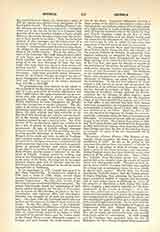

Georgius Syncellus (Gr. Georgios ho Sugkellos); d. after 810; the author of one of the more important medieval Byzantine chronicles. Not much is known of his life. He had lived many years in Palestine as a monk; under the Patriarch Tarasius (784-806) he came to Constantinople to fill the important post of syncellus. The syncellus is the patriarch’s private secretary, generally a bishop, always the most important ecclesiastical person in the capital after the patriarch himself, often the patriarch’s successor. But George did not succeed Tarasius. Instead, when his patron died he retired to a monastery and there wrote his chronicle. The only date we know at the end of his life is 810 (6302 an. mundi), which he mentions (Dindorf’s edition, 389, 20, see below) as the current year. The chronicle, called by its author, “Extract of Chronography” (Eklog? chronographias), contains the history of the world from the Creation to the death of Diocletian (316). It is arranged strictly in order of time, all the events being named in the year in which they happened. The text is continually interrupted by long tables of dates, so that Krumbacher describes it as being “rather a great historical list [Geschichtstabelle] with added explanations, than a universal history” (Byzantinische Litteratur, 2nd ed., Munich, 1897, 340). The author has taken most trouble over the Bible history, the chronology of the life of Christ and the New Testament. For later times he is content with a compilation from Eusebius (Church History and Canon) and one or two other historians (the Alexandrines Panodorus and Annianus especially; see Gelzer, op. cit. infra). He took trouble to secure good manuscripts of the Septuagint and did some respectable work as a critic in collating them. He also quotes Greek Fathers—Gregory Nazianzen and Chrysostom especially. His interest is always directed in the first place to questions of chronology. The “Extract of Chronology” has merit. Krumbacher counts it as the best work of its kind in Byzantine literature (op. cit., 341). That the author thinks the Septuagint more authentic than the Hebrew text—of which he could read nothing at all—is a harmless and inevitable weakness in a Greek monk. Georgius Syncellus’s chronicle was continued by his friend Theophanes Confessor (Theophan?s homolog?t?s). Anastasius Bibliothecarius composed a “Historia tripartita” in Latin, from the chronicle of Syncellus, Theophanes, and Nicephorus the Patriarch (806-815). This work, written between 873 and 875 (Anastasius was papal librarian), spread Syncellus’s chronological ideas in the West also. In the East his fame was gradually overshadowed by that of Theophanes.
ADRIAN FORTESCUE

